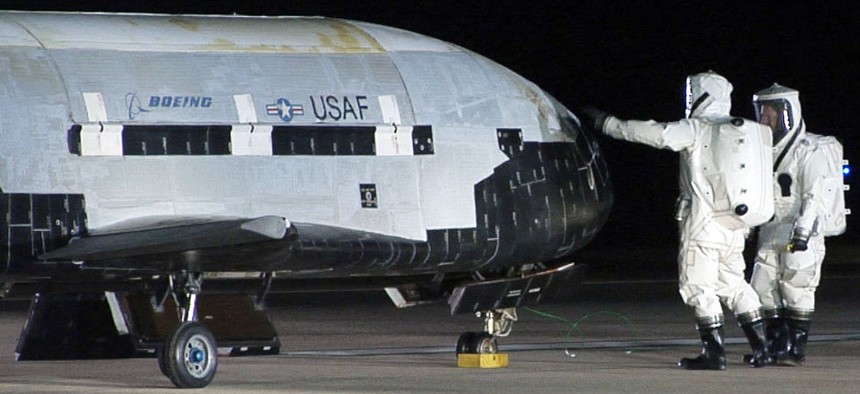Top-Secret US Space Drone Returns to Earth

Technicians examining the X-37B unmanned spaceplane shortly after landing Friday Dec. 3, 2010 at Vandenberg Air Force Base, Calif. Vandenberg Air Force Base/AP File Photo
Experts say the highly classified plane—which returns to Earth today—could be testing spacecraft longevity or developing anti-satellite weapons.
America’s top-secret space drone is coming home today after a record 22 months in orbit—and we have no idea how it spent its time up there.
The X-37B, made by Boeing for the U.S. Air Force, is catnip for space fans, but despite lots of public interest and plenty of speculation, we know next to nothing about the futuristic craft.
“Unfortunately, because the X-37B program is highly classified, our contract stipulates that we not discuss the program publicly,” a Boeing spokesperson toldQuartz last year. “We in fact have never done any interview on this program, on or off the record.”
The space plane—at 30 ft. long, it’s about a quarter of the size of the space shuttle—is launched on top of a rocket, but can fly back to Earth and land, just as the shuttle could. But what has it been doing up there in the meantime?
For a while, people thought it might be part of a plot to spy on Tiangong 1, China’s space station. But their two orbits don’t match up well for eavesdropping, something that even amateur astronomers can discern.
“Then the question is, is [spying on the space station] something that’s useful from the X-37B?” asks Dean Cheng, a researcher at the Heritage Foundation and a skeptic of that theory. “Are there other satellites up there, are there recon satellites, that can also do the job of imaging the Tiangong and might actually do it better, more efficiently, in more detail?”
Cheng suggests that at least part of the X-37B’s mission is simply testing spacecraft longevity in orbit, dealing with solar flares and micro asteroids. The project’s developers have also mentioned asteroid mapping and, intriguingly, the release of smaller satellites from the vehicle’s payload bay.
Other speculation has focused on the efforts to develop anti-satellite weapons or other space-based armaments, but that would be in violation of international treaties—and risky, as China’sexperiments gone wrong with anti-satellite weapons have shown us. Given the global scrutiny of X-37B, it would have been difficult for any major maneuvering to go unnoticed.
The best answer, according to aerospace industry observers, is that the craft is a testing bed for a variety of long-range sensors technology that the Air Force doesn’t want to put into space permanently on a satellite, while taking advantage of X-37B’s ability to move around in orbit and eventually return to Earth for re-use. But even that would be somewhat unusual: The Air Force doesn’t focus much on ground-based surveillance; its satellite constellation is focused on communications and aerospace surveillance. The U.S. National Reconnaissance Office operates the U.S. spy satellites that watch the earth.
But there may even be a more prosaic explanation. This month, NASA announced that it was handing over the hangars and facilities that formerly housed the Space Shuttle program to the Air Force, for use with the X-37B. In the past Boeing has hinted that it will develop a manned version of the X-37 for the Air Force. As NASA turns to private companies for access to space, perhaps the Air Force, too, would simply like its own manned space plane.






